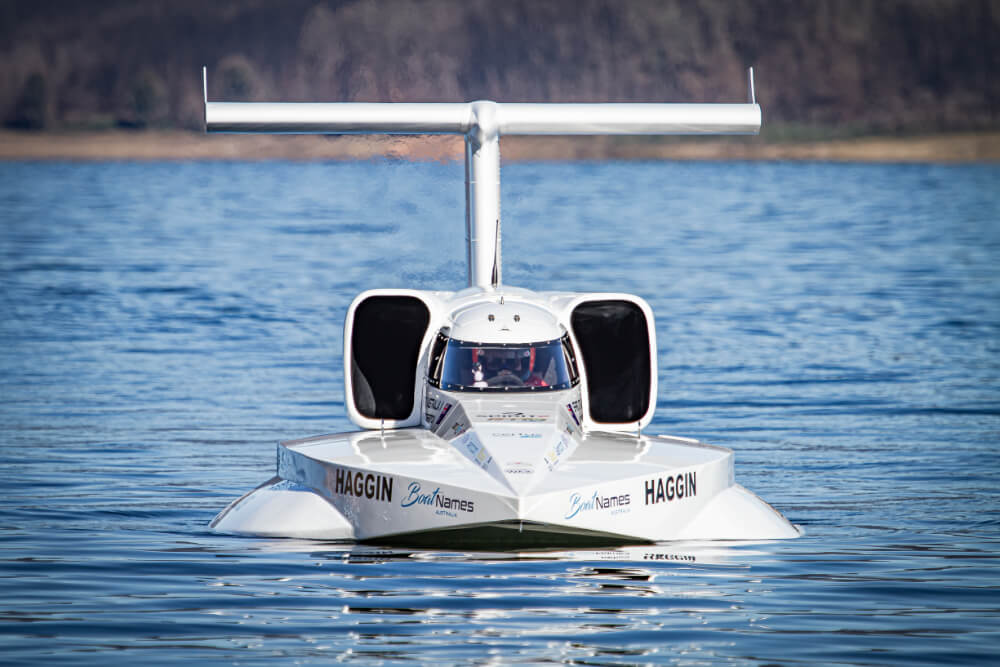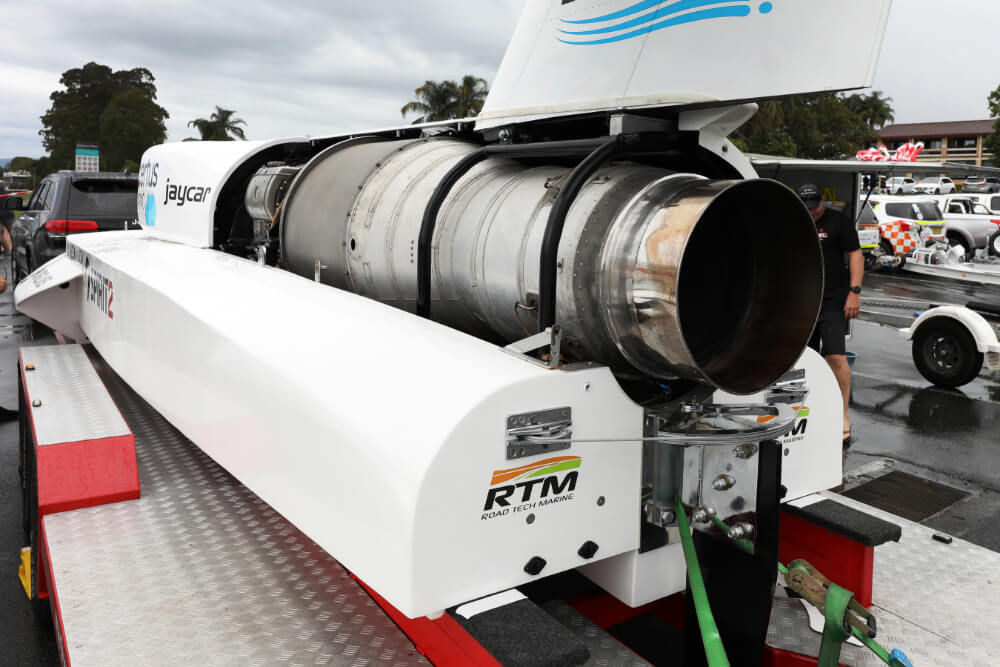Spirit of Australia 2 sports a Rolls Royce Orpheus jet that last saw active service in the 1990s.
David Warby & Spirit of Australia 2
Images by Mark Rothfield & Jeff Barnett
For a man hellbent on breaking the world water-speed record, Australia’s David Warby is in no rush to go too fast too soon. Mark Rothfield talked to him about his on-going obsession, to become the world’s fastest man on water.
A good many speed bumps have hindered his spirited bid – COVID restrictions, handling tweaks and inclement weather among them. And just when he finally went to blow out the cobwebs in January, after a 10-month hiatus, police closed his river runway to search for missing man.
Tragically, a body was located in the afternoon and the entire day was lost for Warby’s Spirit of Australia 2 team. They did manage several successful runs the next day though.
Beyond that, however, it has been a case of safety fast for Warby as he gradually builds momentum towards breaking the world record set over 40 years ago by his legendary father, Ken. Rolling the dice is not an option in the crapshoot world of speed records.
Through his genes, his hands and his backside, David Warby instinctively knows when something’s amiss and when to ease off the pedal. Having built Spirit 2 with his own two hands, every inch is an extension of him. Drivers who didn’t know their boats so well – well, they’re no longer with us.
On a recent test run, while topping a whopping 400km/hr, the hydroplane’s tail began to power slide, demanding a quarter turn of the wheel in the blink of the eye. David’s immediate attention was on decelerating safely, braking distance at this speed being about 1.8km; roughly the same as a loaded freight train doing 90kmh.

Only later did he ponder the potential danger. It wasn’t a gust, nor an untimely ripple, it was a set-up issue that caused the jet-powered speed machine to react so skittishly.
“This is why it’s crucial to gradually build our speeds and learn along the way, not just accelerate the boat or hold the sustained speed,” Warby says.
“I’ve got extreme respect for what I’m driving. My attention isn’t focused on ‘wow, this feels exciting and great’. It’s really focused on, ‘right, what’s the boat doing now?’ … Dad always told me that you have to feel the boat, and be part of it. It’s very true.”

‘Dad’, as mentioned, is Ken Warby – holder of the current record mark of 317.6 mph (511km/h) set in 1978 by Spirit of Australia 1. Someone worth listening to, then.
Ken, at the tender age of nine, watched Donald Campbell running Bluebird then he promptly built a working scale model with a Jetex micro rocket motor. It scurried across a small pond in suburban Newcastle, NSW, fuelling a lifelong passion as it went.
At 13, Ken began building a full-size boat, to which he fitted a Ford Prefect inboard engine. David would eventually build his own first race boat in the same shed, using the original tools passed down from his grandfather.

“If you look back on the history of the water speed record, Dad’s the only one to build and design his own boat,” David adds.
EVOLUTION OF SPIRIT 2
Father and son worked cheek-and-jowl in designing Spirit 2 as an evolutionary offshoot of the original, which is now displayed permanently at the Australian National Maritime Museum.
They added a foot in length to round out at 30ft (9.1m), this extra footprint helping to dampen the pitching. Gunwale height is also marginally higher to accommodate a larger, albeit lighter, jet. Overall weight is 2.5t. Beam was determined by the legal towing width, just like every other trailable runabout.

“I’ve obviously got a lot of background information from Dad’s experience, so we’re not reinventing the wheel, just balancing it. Pumping the tyre up,” Warby adds.
Speaking of balance, the aforementioned handling issue resulted from the centre of gravity being slightly too far forward, which meant shuffling some weight aft and integrating a new tailplane. The design always allowed for this $60,000 addition … David’s initial budget didn’t.
That’s where he and his team are at now, fine tuning the hull balance so it feels comfortable maintaining high speeds over long distances, even though it only has to run a timed kilometre. “I reckon we’re pretty close to solving it with the wing,” Warby reveals. “The faster you go, the smoother it is.

“I held 200mph (322kmh) for about four kilometres and it felt really good. The boat will look like it’s dragging its rear a bit, and the nose up a bit, but that’s its happy zone.”
Where Spirit 1 was the least powerful speed-record jetboat built, yet also the fastest – a testament to its hydrodynamics and aerodynamics – its predecessor has twice the power and the potential to crack 350mph (563kmh).
The newer generation jet harnesses the equivalent of 10,000hp, its turbines spinning at a mind-blowing 10,000rpm. Warby has to apply the power gently since the immense torque can tilt the hull to starboard, yet acceleration is far more rapid than Ken’s boat.

David also has every conceivable safety feature at his disposal, including a carbon/kevlar cockpit, six-point harness, on-board air system, GPS tracking, three-stage fire extinguisher and positive flotation. Ken didn’t even wear a seatbelt …
So what’s it like to drive? Is there a key to start the beast, or a red ‘launch’ button under a missile switch cover? Er, no, just a plain button, says David, adding that the main thing with starting a jet is keeping an eye on the exhaust gas temperature (EGT). He lets the motor spool up before introducing the fuel.
A foot pedal, like in your garden-variety car, leaves two hands for the wheel.

A tap on the throttle brings 35 per cent thrust, the equivalent of idle, to get the show on the road but little more. Off go the starter and the igniter. The big power comes way, way later.
When running on his test site, Blowering Dam, folk can hear the roar from 15 kilometres away. David can’t, even though the motor’s more like 15cm away and the hull intakes are gulping copious amounts of air: “I wear earplugs with speakers in them but, no, I just hear a whistling sound more than anything.”
There are fuel, temperature and oil warning lights on the dash to monitor occasionally. Revs are measured by a military-spec percentage gauge.

“We run the boat like an aircraft. Every bit of work that’s done on it, every change, every time it’s run, the exhaust gas temperature, every start, every service … it’s recorded on an aircraft log,” Warby adds.
THE RIGHT TEAM
“A few of the guys were on dad’s team and one is a retired squadron leader from the [RAAF] F-18s. That’s seriously the backbone of what we’re doing … I don’t care how much money you’ve got, if you don’t have the team of people, you haven’t got anything.”
Currently, Warby Motorsport is the only team in the world actively pursuing a record, but David believes there are many who naively think, “if Ken Warby can do it, I can do it too”.

“They all overlook his determination, his ability, his focus, and his boating background. That’s what catches them all out.
“Right now, we’ve got everything to achieve the record. It’s just getting the time on the water to safely build it to that speed. I get bugged all the time but we’ll break it when it’s broken.”
It was David’s idea to go after the record, which in some ways juxtaposes his mild-mannered and measured demeanour. When he changes into his race suit, does he turn into a speed demon?
“No, no. Not at all. I think that gets you into trouble. I’ve been around this my whole life, and you just know what’s right and what’s wrong.

. You’ve got to understand what you’re driving, you’ve got to know how to drive it, and you’ve got to be able to solve problems.
“Every hour of my life, I’m thinking about how I can fix the boat, and how I can make it go better. The real excitement is sorting it out, and solving the problems”
So, it’s not about the thrill of the speed, it’s the chase, in a way.
“It hasn’t been a walk in the park with this boat, but as my dad would say, it’s about building the better mouse trap.
“You’re backing your decisions, you’re backing your design, and that’s the real thrill of it. Look, I’m not saying it’s boring; the driving is fun. I like it, I’m never scared to get in the boat … but if something’s not right, you don’t just push on because it’ll probably be the last time you push on.”
I’ve got extreme respect for what I’m driving
I held 200mph (322kmh) for about four kilometres and it felt really good




